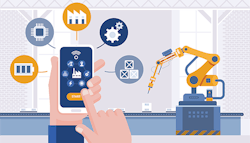Not all that long ago, typical machine diagnostics were limited to local indicators such as HMI popups, stack lights and annoying sonalert alarms. These were intended more for the operator to keep the machine running than for any other audience, and the event that caused the indicator may or may not have even been logged in the control software for review later, much less communicated to engineering, maintenance or operations.
The only real way to see what was happening real-time in the system was to connect it to a development tool or laptop. It wasn’t because the events were unimportant, but because the ability to communicate the information easily and effectively from the control system to the outside world did not exist, or because those tools were difficult or expensive to implement.
Also read: The Log4j vulnerability: What is it, and should I be concerned?
Fast forward to the present time, and oh how things have changed. Most control systems installed in the past 20 years or so have at least some level of remote monitoring and diagnostic capabilities, provided that the machine builder or controls engineer enabled and utilized them in programming the controls system in the first place.
Internet-based communication capabilities driven by the Internet of Things (IoT) and Industry 4.0 have helped to bring many of these data parsing features into the mainstream, especially in the past decade.
What are remote monitoring and diagnostics?
Although the term seems simple, it can have different meanings to differing audiences. Engineers and technicians may immediately think of reactive data to help troubleshoot a faulty system, perhaps an SMS message in the middle of the night indicating that a system is not functioning correctly; perhaps the engineer can pull up a remote monitor on the tablet or phone, which allows that individual to troubleshoot, diagnose and correct the problem or tell maintenance which component needs replacement, without ever having to get in the car or on a plane.
Operations may be interested in the uptime data of each line and the causes of downtime or changes in quality or efficiency and planning upcoming stops in production to address calculated sensors, motors or actuator end-of-life swaps from prior data.
Management will definitely be interested in the same data as operations, but might also wish to work with engineering and operations to see which changes or improvements should be funded to bring uptime, efficiency and quality to higher levels.
How remote is remote?
The beautiful thing about “remote” is that it doesn’t matter if the access is from across the room or from the other side of the world, as, theoretically, the interface is the same. As long as the connection to the system is sufficiently secure—VPN or similar—the only differences to what you can do remotely are determined by the features that are built in to the diagnostic and monitoring capabilities.
For instance, data indicating running status of the program or I/O communication or sensors is easily implemented, but what about making program changes or uploading entire runtime images?
Let’s start with some more extreme examples of remote monitoring and diagnostics, such as a remote installation many miles away from technical resources, or perhaps not easily accessible because of other factors, or, at the extreme, even outer space.
Having the ability to be aware of abnormal system behavior and then be able to correct and even make program changes without having to send an engineer or technician to the site, if it’s even possible, saves downtime, money and wear and tear on the engineering staff. Some earthbound examples might be remote data centers, wind turbines, jack pumps or even farm irrigation systems.
Not quite as remote as the above examples, having the ability to monitor multiple factory lines or systems from a central location, such as the desk of an engineer or the operations center of a factory, could not be done without remote diagnostic data. But these same features that enable engineers to monitor the system from their desks will also enable them to troubleshoot the system while on vacation in Cabo. All they need is an Internet or cell connection.
Security
Of course, connectivity into an operating machine or control system is always a security concern, so planning the implementation with a focus on operational security is a high priority. Utilizing the various VPN technologies, secure encryption and strong passwords for engineering logins for making program changes are highly recommended.
For the majority of remote monitoring and diagnostic implementations, read-only data, such as displaying on secure Web pages, should be used. A common way to implement one-way communication is to upload the data directly to a cloud service and pull the parameters from the cloud to the Web-based display pages. This one-way, read-only approach prevents any parameters from being able to be changed remotely.
About the Author

Joey Stubbs
contributing editor
Joey Stubbs is a former Navy nuclear technician, holds a BSEE from the University of South Carolina, was a development engineer in the fiber optics industry and is the former head of the EtherCAT Technology group in North America.

Leaders relevant to this article:

